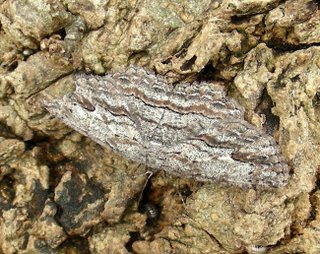 I found this moth on my curtains the other morning. Wanting to give it a chance, I caught it in a jar and put it aside for release that night. While captive, the moth laid a batch of eggs so green I thought they might be fluorescent. Now I was responsible not only for the welfare of the moth but of her scores of offspring as well.
I found this moth on my curtains the other morning. Wanting to give it a chance, I caught it in a jar and put it aside for release that night. While captive, the moth laid a batch of eggs so green I thought they might be fluorescent. Now I was responsible not only for the welfare of the moth but of her scores of offspring as well.I released her late in the afternoon. But what about those bloody eggs? I didn't know what sort of moth it was—entomologists have described more than 10,000 species from Australia and they all look the same. (The moths, not the entomologists.) So I didn't have much chance of identifying this mid-sized, nondescript, unassuming sort of moth. Well ... maybe it was a geometrid. Then again, maybe not.
 Then I forgot about the candy-green eggs for a few days. When I looked again, they'd all turned white. Were they mouldy? I opened the lid to check and about a hundred tiny caterpillars inched out. Yep, the were geometrids. Their looping head-and-tail movement was characteristic. And the poor little devils must have been starving.
Then I forgot about the candy-green eggs for a few days. When I looked again, they'd all turned white. Were they mouldy? I opened the lid to check and about a hundred tiny caterpillars inched out. Yep, the were geometrids. Their looping head-and-tail movement was characteristic. And the poor little devils must have been starving. I took a punt and tipped them onto the most productive Proteaceae in the garden, a small firewheel tree (Stenocarpus sinuatus). It was all I could think of doing. Now the leaves are looking mighty ragged. You just can't win, can you?